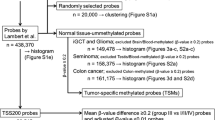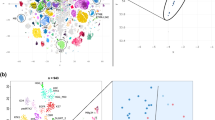Abstract
Germ cell tumours (GCTs) are a diverse group of neoplasms all of which are generally believed to arise from germ cell progenitors (PGCs). Even those that form in the nervous system are likewise believed to be PGC-derived, despite being found a great distance from the normal location of germ cells. The primary evidence in favour of this model for the origins of intracranial GCTs is that they share molecular features with other GCTs. Those features include shared gene expression and a lack of methylation of imprinted genes, including SNRPN. Contrary to this model, we have proposed that endogenous neural stem cells of the brain are a more likely origin for these tumours. We show here that the lack of methylation of SNRPN that has previously been taken to indicate an origin for GCTs from PGCs is also seen in neural stem cells of mice and humans. We believe that, in the light of these and other recent observations, endogenous neural precursors of the brain are a more plausible origin for intracranial GCTs than are misplaced PGCs.








Similar content being viewed by others
References
Gobel U et al (2000) Germ-cell tumors in childhood and adolescence. GPOH MAKEI and the MAHO study groups. Ann Oncol 11:263–271
Lieuw K, Haas-Kogan D, Ablin A (2004) Intracranial germ cell tumours. In: Gupta N, Banerjee A, Haas-Kogan D (eds) Pediatric CNS tumors. Springer, Berlin, pp 107–121
Freeman B (2003) The active migration of germ cells in the embryos of mice and men is a myth. Reproduction 125:635–643
Runyan C, Gu Y, Shoemaker A, Looijenga L, Wylie C (2008) The distribution and behavior of extragonadal primordial germ cells in Bax mutant mice suggest a novel origin for sacrococcygeal germ cell tumors. Int J Dev Biol 52:333–344
Schneider DT et al (2001) Multipoint imprinting analysis indicates a common precursor cell for gonadal and nongonadal pediatric germ cell tumors. Cancer Res 61:7268–7276
Sievers S et al (2005) IGF2/H19 imprinting analysis of human germ cell tumors (GCTs) using the methylation-sensitive single-nucleotide primer extension method reflects the origin of GCTs in different stages of primordial germ cell development. Genes Chromosomes Cancer 44:256–264
Rivera MN, Haber DA (2005) Wilms’ tumour: connecting tumorigenesis and organ development in the kidney. Nat Rev Cancer 5:699–712
Zhan S, Shapiro DN, Helman LJ (1995) Loss of imprinting of IGF2 in Ewing’s sarcoma. Oncogene 11:2503–2507
Zhan S, Shapiro DN, Helman LJ (1994) Activation of an imprinted allele of the insulin-like growth factor II gene implicated in rhabdomyosarcoma. J Clin Invest 94:445–448
Kondo M et al (1995) Frequent loss of imprinting of the H19 gene is often associated with its overexpression in human lung cancers. Oncogene 10:1193–1198
Kohda M et al (2001) Frequent loss of imprinting of IGF2 and MEST in lung adenocarcinoma. Mol Carcinog 31:184–191
Nishihara S et al (2000) Multipoint imprinting analysis in sporadic colorectal cancers with and without microsatellite instability. Int J Oncol 17:317–322
Bussey KJ et al (2001) SNRPN methylation patterns in germ cell tumors as a reflection of primordial germ cell development. Genes Chromosomes Cancer 32:342–352
Oosterhuis JW, Stoop H, Honecker F, Looijenga LH (2007) Why human extragonadal germ cell tumours occur in the midline of the body: old concepts, new perspectives. Int J Androl 30:256–263 discussion 263–264
Scotting PJ (2006) Are cranial germ cell tumours really tumours of germ cells? Neuropathol Appl Neurobiol 32: 569–574
Li JY, Lees-Murdock DJ, Xu GL, Walsh CP (2004) Timing of establishment of paternal methylation imprints in the mouse. Genomics 84:952–960
Rugg-Gunn PJ, Ferguson-Smith AC, Pedersen RA (2005) Epigenetic status of human embryonic stem cells. Nat Genet 37:585–587
White HE, Durston VJ, Harvey JF, Cross NCP (2006) Quantitative analysis of SRNPN gene methylation by pyrosequencing as a diagnostic test for Prader–Willi syndrome and angelman syndrome. Clin Chem 52:1005–1013
Hemberger M et al (1998) H19 and Igf2 are expressed and differentially imprinted in neuroectoderm-derived cells in the mouse brain. Dev Genes Evol 208:393–402
Hajkova P et al (2002) Epigenetic reprogramming in mouse primordial germ cells. Mech Dev 117:15–23
Donato R et al (2007) Differential development of neuronal physiological responsiveness in two human neural stem cell lines. BMC Neurosci 8:36
Schmittwolf C et al (2005) In vivo haematopoietic activity is induced in neurosphere cells by chromatin-modifying agents. EMBO J 24:554–566
Galli R et al (2000) Skeletal myogenic potential of human and mouse neural stem cells. Nat Neurosci 3:986–991
Clarke DL et al (2000) Generalized potential of adult neural stem cells. Science 288:1660–1663
Denham M et al (2006) Neural stem cells express non-neural markers during embryoid body coculture. Stem Cells 24:918–927
Kim JB et al (2009) Oct4-induced pluripotency in adult neural stem cells. Cell 136:411–419
Kim JB et al (2009) Direct reprogramming of human neural stem cells by OCT4. Nature 461:649–653
Hu JF, Vu TH, Hoffman AR (1995) Differential biallelic activation of 3 Iinsulin-like growth factor-II promoters in the mouse central nervous system. Mol Endocrinol 9:628–636
Pedone PV et al (1994) Parental imprinting of rat insulin-like growth factor-II gene promoters is coordinately regulated. J Biol Chem 269:23970–23975
Pham NV, Nguyen MT, Hu JF, Vu TH, Hoffman AR (1998) Dissociation of IGF2 and H19 imprinting in human brain. Brain Res 810:1–8
Ruau D et al (2008) Pluripotency associated genes are reactivated by chromatin-modifying agents in neurosphere cells. Stem Cells 26:920–926
Mikkelsen TS et al (2008) Dissecting direct reprogramming through integrative genomic analysis. Nature 454:49–55
Acknowledgments
We greatly appreciate the support of the Children’s Cancer and Leukaemia Group (CCLG), especially Dr Juliet Hale and Professor Richard Grundy. VA was supported by The Samantha Dickson Brain Tumout Trust. JNJ was supported by Ali’s Dream and Charlie’s Challenge. RDP, JCN and NC are supported by the MRC, CRUK, CLIC Sargent, The Parthenon Trust and Addenbrooke’s Charities.
Author information
Authors and Affiliations
Corresponding author
Rights and permissions
About this article
Cite this article
Lee, SH., Appleby, V., Jeyapalan, J.N. et al. Variable methylation of the imprinted gene, SNRPN, supports a relationship between intracranial germ cell tumours and neural stem cells. J Neurooncol 101, 419–428 (2011). https://doi.org/10.1007/s11060-010-0275-9
Received:
Accepted:
Published:
Issue Date:
DOI: https://doi.org/10.1007/s11060-010-0275-9




